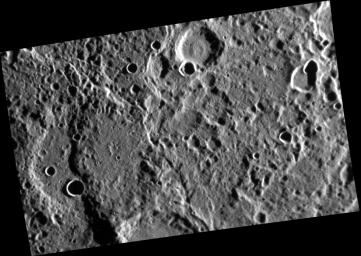
|
Cliffs, Notes
- Click the image above for a larger view
- Full-Res JPEG (1790 x 1271) (270.0 kB)
- Full-Res TIFF (1790 x 1271) (2.3 MB)
Caption:
This image was obtained from an oblique viewing perspective. In the left part of the scene an impressive lobate scarp (curving cliff) can be seen. " Rupes " is the Latin term used in planetary nomenclature for such a cliff. This one, named Vostok Rupes, was first seen by Mariner 10. The name, for the ship used by Bellingshausen for Antarctic exploration (1819-21), was adopted by the IAU in 1976.
This image was acquired as part of the NAC ride-along imaging campaign. When data volume is available and MDIS is not acquiring images for its other campaigns, high-resolution NAC images are obtained of the surface. These images are designed not to interfere with other instrument observations but take full advantage of periods during the mission when extra data volume is available.
Date acquired:
July 08, 2013
Image Mission Elapsed Time (MET):
15651538
Image ID:
4406818
Instrument:
Narrow Angle Camera (NAC) of the Mercury Dual Imaging System (MDIS)
Center Latitude:
-36.52°
Center Longitude:
341.8° E
Resolution:
125 meters/pixel
Scale:
The scene is about 205 km (127 mi.) across
Incidence Angle:
78.2°
Emission Angle:
51.0°
Phase Angle:
129.2°
Background Info:
The MESSENGER spacecraft is the first ever to orbit the planet Mercury, and the spacecraft's seven scientific instruments and radio science investigation are unraveling the history and evolution of the Solar System's innermost planet. MESSENGER acquired over 150,000 images and extensive other data sets. MESSENGER is capable of continuing orbital operations until early 2015.
For information regarding the use of images, see the MESSENGER image use policy .
Cataloging Keywords:
| Name | Value | Additional Values |
|---|---|---|
| Target | Mercury | |
| System | ||
| Target Type | Planet | |
| Mission | MESSENGER | Mariner |
| Instrument Host | MESSENGER | Mariner 10 |
| Host Type | Orbiter | Flyby Spacecraft |
| Instrument | Mercury Dual Imaging System (MDIS) | |
| Detector | Narrow Angle Camera (NAC) | |
| Extra Keywords | Grayscale, Radio | |
| Acquisition Date | ||
| Release Date | 2013-09-02 | |
| Date in Caption | 2013-07-08 | |
| Image Credit | NASA/Johns Hopkins University Applied Physics Laboratory/Carnegie Institution of Washington | |
| Source | photojournal.jpl.nasa.gov/catalog/PIA17450 | |
| Identifier | PIA17450 | |
